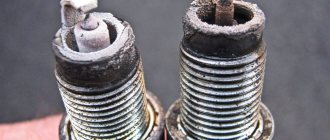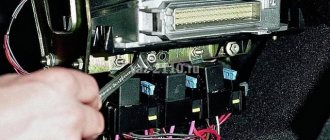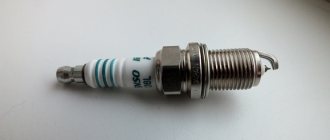Author:
Maxim Markov
Greetings, friends! Tell me, where have you seen an ordinary domestic driver screw in the spark plug correctly, as the installation instructions advise? To be honest, I myself started to worry about this a relatively short time ago. Then, when I learned the possible consequences of poor-quality installation, I immediately changed my approach to this matter! Remember, the tightening torque of the spark plugs plays a key role in the efficiency of the part; its incorrect value can easily destroy not only the spark plug itself, but also the engine! I strongly recommend that you pay attention to such a trifle; believe me, you shouldn’t listen to ignorant drivers who will try to prove the opposite to you! No matter how you feel the key, tightening it by eye is not an option!
Main reasons to follow the recommendations
It turns out that all these drawings on packages of spark plugs are far from comics, and not diagrams for nerds. You can’t ignore them, otherwise don’t be surprised if the part starts to act up! You probably noticed that there is a washer on the threaded part, but have you ever thought about its purpose? According to manufacturers, this metal ring plays a vital role in the process of removing heat from the part. And if the tightening is weak, the candle will not work stably!
And this is just the beginning! More than 90% of breakdowns occur precisely due to improper installation. A low tightening torque leads not only to overheating of the spark plug, but also to loss of compression of the power unit. As a result, vibration appears, which can damage the central electrode or insulator.
However, you should also never overdo it; pharmacy precision is needed here! Otherwise, it is likely that the annular gap between the glow tube and the steel body will narrow, the spark plug will overheat and fail forever, and may even fire. A deformed body and cracked ceramics also indicate that the spark plugs were not installed professionally! And you don’t even have to ask how to calcinate the spark plugs, in this situation it’s pointless!
Operating principle and device
It is necessary to understand the principle of operation of a torque wrench, because without this you will not be able to properly use the capabilities of this tool.
The device resembles a regular ratchet. But the key difference here is the presence of a special scale. It displays the force that the user applies to the fastener.
The tool is based on a handle that can rotate in two directions. The main scale is applied to the body, and there is an additional one on the handle. The main scale is intended to demonstrate the range of forces relevant to each specific torque wrench.
In reality, it is not difficult to understand how a special torque wrench for a car works. Although they come in different types, the devices are designed approximately the same. The design of a torque wrench depends on its type. Let’s look more specifically at the features of working with pointer, click and electronic devices.
Many motorists who work on their cars independently know what a torque wrench is for. It allows you to apply the required force with maximum precision when tightening threaded connections. That's what a torque wrench is for. This is a device for tightening nuts and bolts with a given and measured force
It is important to know how it is measured. Then it will be easier to understand how to correctly calculate the tightening and pre-set the tool
This force is measured in Newton meters (Nm).
Craftsmen working at service stations can hardly imagine a set of tools for servicing customer cars that does not include a torque wrench. With its help, precise force is measured. These measurements help prevent leaks, depressurization, and breakdown of vehicle components and mechanisms.
The keys have different attachments that are adapted to perform certain tasks. Therefore, it is a universal device with wide functionality. To use one or another attachment, an output square is used. The user mounts a horn-type, union-type or nut-type attachment on it. Don’t forget about screwdriver wrenches, which are useful when working with electronics and very fragile car mechanisms.
The differences between keys of different types are minor. All of them must include in their design:
- handle;
- clamp for setting the torque;
- measuring component or setting scale;
- removable attachment (ratchet);
- socket for nozzles;
- housing with a spring mechanism.
Before purchasing a torque wrench, be sure to consider what specific tasks it will be used for. The main role is played by the size of the fasteners and their location. For hard-to-reach places, it is more convenient to use click and horn devices. And the tool with maximum precision is an electronic type of torque wrench. Although such devices are mainly used in car repair shops, they are not really needed for personal use.
Correct installation of the spark plug
In one of my previous publications, I already told you everything about replacing spark plugs, but, to be honest, I kept silent about how much force you need to apply when tightening them. I’ll fix this problem right now, armed with just two tools (a regular spark plug and a torque wrench), you can get started.
- Make sure the outside of the spark plug is clean to prevent debris from getting into the engine.
- Check if the sealing washer is in place!
- Place the spark plug vertically and use a spark plug wrench to tighten it to the limit by hand.
- Afterwards, special equipment comes into play, that is, a torque wrench, with its help the tightening torque and angle of rotation are adjusted according to the table, which is located slightly below.
Denso spark plugs are installed in this way; in principle, the same rules must be followed in the case of any similar part, regardless of the brand of manufacture! The only exception concerns the issue of thread lubrication; some companies recommend it; Denso, on the contrary, is opposed to such prevention. The choice is explained simply - the presence of lubricant leads to excessive tightening, and this is extremely undesirable!
When asked what can be used to lubricate the spark plugs before installing them, I answered with graphite lubricant, naturally coated with a thin layer. As you can see, everything is quite simple, the main thing is to have a torque wrench and a table of recommended values. I provided the diagram, all you have to do is get the tool!
Tightening the nuts: is a torque wrench really necessary?
Reading time:
When carrying out vehicle maintenance, questions often arise that are only briefly discussed on forums or in the literature. One of them is the tightening torque of the fastenings of the main components of the car. To clarify all the nuances of fastening the cylinder head bolts, we will concentrate on the engine, the “heart” of the car. And if you understand the principles of tightening torque for threaded connections, the knowledge gained will be easy to extrapolate to any vehicle component.
Tighten the bolts correctly
Any threaded connection is designed for a certain tightening torque. It is regulated by industry quality standards, for example, “OST 37.001.050–73 Tightening of threaded connections. Tightening standards" and guidelines from vehicle manufacturers. Foreign manufacturers use other standards, but they are basically similar to domestic ones. The information below will be presented based on Russian standards.
To what extent can threaded connections be tightened?
Why is it important to maintain the correct tightening torque? Only proper tightening will ensure reliable fixation of the part, on the one hand, and prevent damage to the thread and/or the part itself, on the other hand.
Let's look at what happens when the tightening torque is exceeded using the example of a bolt and nut:
- Immediate thread deformation. Due to too much applied force, deformation and breakage of the threads on the part occurs. The bolt or nut is not subject to further use; in addition, certain difficulties will arise when trying to unscrew the nut for replacement. You will most likely need to use a drill or metal saw to cut off the nut.
- Damage to metal hidden from view. It may seem that the nut is tightened correctly, but due to exceeding the yield strength, irreversible changes occur in the bolt or nut: deformation, disruption of the metal crystal lattice. Such a case is especially dangerous because it is not immediately noticeable, but after some time a crack in the bolt can lead to dire consequences.
Advice from manufacturers
Let's return to our "comics", if you have ever bought new spark plugs, you might have paid attention to some quick installation instructions. Different companies have such instructions that look completely different; some manage to sell their products without such hints at all.
Of course, the main information in such factory advice is the exact tightening torque for a specific spark plug. So you need to carefully examine not only the desired part, but also the box from under it. Let's take a quick look at the main brands of the domestic market, how do they approach this issue?
- Bosch - on the set of spark plugs I purchased from this company, there is no useful information at all, although the tightening torque is still indicated in the corner on the individual candle box. As the salesperson of the car dealership explained to me, on other models of the same company they also tell you at what angle to tighten the spark plug, nothing more.
- Denso - here everything is the other way around, an excellent installation diagram is printed on the package, however, such an important value for the tightening torque is missing; you can find it out in the online catalog, which you are recommended to visit.
- NGK - they also indicate the tightening torque and the number of turns, but I still don’t understand clearly how much to do ½ or 2/3 of a turn, there are some inconsistencies. However, the official dealer still recommends ½ turn.
And yet, before purchasing new spark plugs, diagnose the old ones. Find a device for checking spark plugs if you can’t do it with improvised means. It is quite possible that they can be heated and kept in reserve; do not rush to throw them away.
German "Meriva"
Each car has a spark plug tightening torque indicated in its passport data. Opel Meriva uses a spark from a gap of 1.1 mm. Replacement is made with a 16 mm wrench. To gain access, remove the plastic cover, remove the connectors and unscrew the 2 bolts.
The first step is to remove the coil block along with the spark plugs. Carry out an external inspection for the presence of soot and chips. To tighten it, it is better to use a spark plug wrench with a rubber insert. You will also need sprockets for dismantling decorative elements in the engine compartment. For installation, reverse manipulations are carried out, the tightening torque is 25 Nm.
The spark plugs must be crimped with a certain force to the gasket thickness specified by the manufacturer. Ideally, it should be equal to 1.7 mm. But inexperienced repairmen manually turn it up to 1.2 mm, when the risk of damaging the ceramic inserts increases.
Conical spark plugs are more fragile and require torques with a low error of ±2 Nm. Therefore, it is better to buy an original torque wrench. Cheap tools are usually disposable. Good spark plugs also cost a lot compared to the cost of a key.
Drewpatch68 › Blog › How hard should I tighten the spark plugs?
The information is not new, however, if, for example, you survey 100 car owners, then only a few will answer the question “with what force to tighten the spark plugs” correctly. Usually, car enthusiasts answer this question with something like “I tighten it by hand,” “I didn’t even think about it,” “I pull it until it stops,” “It doesn’t matter!” and so on.
What is this article for and why did I even take it up? At one seminar, I heard an interesting explanation from an official Bosch representative in Kazakhstan about overheating of spark plugs when they are installed incorrectly in the engine block head. To be honest, before that, I myself had not strictly followed the manufacturers’ instructions, although I had repeatedly seen these recommendations on candle packaging, and like every self-respecting driver, I believed that those small “pictures” on the boxes were indicated either for “nerds” those who love precision, or for those who don’t even have an idea how to screw in spark plugs, or in order not to break the thread in the spark plug well - “well, I’ve been driving for many years and I feel the key!”
The first package of the most standard Bosch spark plugs, which are installed on Nissan, Toyota and other popular brands. On the packaging itself, in which all 10 candles were stored, no information on tightening is given at all. However, on the packaging of each individual candle a wrench is depicted and the tightening torque is indicated - 28 Newton per meter, although on other types of Bosch candles, in addition, a 90-degree turn of the key is also indicated.
Although the tightening torque is not indicated on the packaging of each candle (agree, it wouldn’t hurt to indicate it?), there is an inscription stating that detailed information about installation is indicated in the catalogue, in addition, there is an installation diagram in the form of pictures, where the exact tightening torque values not indicated, but it is indicated that after screwing in the spark plug “by hand”, then you need to tighten it with a wrench 12 turns for a spark plug with a washer-gasket and 116 for a spark plug with a conical seat without a washer - however, please note that there is no inscription anywhere on the packaging that this rule is valid only for new spark plugs, with the washer not yet crushed.
In this very catalog on the applicability of Denso spark plugs there is also a section on installation. I'll try to shed some light on this.
The next point says that you need to screw in the spark plug “by hand”, without using any levers or keys (an extension with a head, in cases where the depth of the spark plug well does not allow this to be done by hand, I think does not count).
This is interesting: How to remove the window lifter handle on Kalina
Finally, in the picture below, I suggest you look at the spark plug washer through which heat is removed. Look at its structure. It's multi-layered. If this washer is not clamped with the required force, the heat dissipation from the internal parts of the spark plug will deteriorate.
In the last article we talked about the correct tightening of spark plugs. Here is this article - How hard should I tighten the spark plugs? Although this installation technology is not new, however, judging by the feedback we received after publication, we confirmed that not many people follow these rules.
From the comments to the article about correct tightening, we have new material for research - the whole point is that one of the discussion participants cast doubt on the fact that the yellow coating around the spark plug is gases escaping through the seals of the metal washer from the combustion chamber. We decided to check it out, and most importantly, show it to you, and we cut exactly the candle that was in the photo in the previous publication.
After loosening the metal washer with a screwdriver, it became clear that the seal was not tight. The color of the ceramic insulator under the washer and in the place where the wire tip was put on is the same. From this experience, we concluded that the ceramics in the washer were indeed not pressed tightly and there was a breakthrough of combustion products to some extent.
Control of additional parameters
It is important to check not only the tightening torque of the spark plugs on your car, but also pay attention to other points during the reassembly process. Check the presence of gaskets between the block and the locking washers. It is also important to check for chips, cracks, and burrs on the metal.
Darkened spark plugs with carbon deposits or altered gaps are not allowed to be reinstalled. It would be useful to check the spark performance on used elements. It is better to do this at a special stand in a car repair shop.
Spark plugs must correspond to the vehicle's passport data for a specific type of fuel. The tightening torque differs depending on the size. It also depends on the condition of the engine: cold or warm. The type of cylinder block material is also taken into account: cast iron, aluminum.
What are the dangers of improper tightening?
Indeed, hardly any novice motorists have thought about how to properly tighten the spark plugs. Well, maybe there are only a few who pay attention to such nuances.
Official information from the manufacturer of the best spark plugs in the world (well, maybe one of the best) Bosch: if the tightening torque is incorrect, the most important elements of the car’s ignition system overheat.
It would seem, well, what’s surprising here. America was not discovered. Such information is present on the packaging of SZ, including those produced in Russia. However, only a few people paid attention to the picture with a wrench, under which the recommended tightening torque is written.
It is noteworthy that a certain part of newcomers think so. Like, I’m cleaning the spark plug, I’ve been driving for a long time, I have experience, I feel the key in my hands, I won’t spoil anything. Another part of people who recently got behind the wheel of a car generally consider this additional information unnecessary.
Obviously, all these beliefs are wrong. It's simple - if you don't follow the instructions on the packaging, you can make a lot of mistakes. This also applies to the ineffective operation of the candle. New relatively SZ require replacement after a short period of use; soot and deposits form on them. Ultimately, this all leads to unnecessary costs.
Newbies often wonder why experienced drivers rarely change spark plugs. For some, this becomes a lesson, they become interested and recognize a simple nuance that has always been in front of them.
It turns out that due to incorrect tightening torque, the SZ breaks or overheats. It is clear that with a strong tightening this threatens breakage, with a weak tightening - loss of compression. In addition, insufficient tightening also threatens breakage, since the spark plug vibrates strongly.
If manually
Often you simply can’t get a torque wrench, and you have to try and find a way out of the situation. The required tightening value of 20 Nm can be calculated. Dividing by 10, we get 2 kg/cm. This corresponds to a weight of 2 kg applied to a 1 meter lever. In this case, the condition of absolute perpendicularity of the load relative to the lever is observed.
Based on the formula F=M/0.1*L=2/0.01*12=16.6 kg, you will need a lever to the key of 10 cm. The calculations indicate: L is the length of the arm or key, for example 12 ( in cm), M=20 Nm=2 kg/cm - moment of force (in kg/cm), F - the desired value, impact force (weight in kg). So, you will need ordinary hand scales with a hook, which we will attach to the round tip of the key and pull so that the arrow is exactly at the level of the 20 kilogram scale.
Moreover, you need to hold the scales perpendicular to the key itself. This way you can get out of the situation when there is no tool store nearby or you just feel sorry for buying a key for one time.
Cause of spark plug overheating
The correct way to tighten the spark plug is of great importance because there is heat generation in the well. So, even the gasket provided at the bottom of the thread, where the top of the cylinder and the seat meet, is responsible for normal heat transfer. Otherwise, if you do not follow the tightening torque instructions (for example, if the spark plug is not tightened enough), overheating will occur. The candle itself will operate with low efficiency.
It turns out to be a whole theory. And in fact, this information is not news, but many have simply forgotten about it.
Unfortunately, there are quite a few kits that do not have specific information on this matter. It happens that just a wrench is shown, but the tightening torque is not indicated.
Required Tools and Process
In order to do it correctly, you will need:
- set of socket heads;
- extension;
- ratchet/wrench;
- torque wrench.
The replacement process itself should be performed according to the following scheme:
- Disconnect the wires leading to the emergency oil level and coolant temperature sensors.
- Drain the coolant.
- Remove the thermostat.
- Remove the air filter housing.
- Disconnect the exhaust pipe inlet from the manifold.
- Remove the casing, as well as the camshaft belt itself.
- Disconnect the drive rods of both dampers from the carburetor.
- Disconnect the wires going to the cylinder head.
- Disconnect the hoses suitable for the cylinder head by loosening their clamps.
- Remove the cylinder head.
- Remove the worn gasket.
- Clean the contact surface of the cylinder head from any remaining gasket material.
Installing the gasket and mounting the cylinder head in place is carried out in exactly the same sequence, but in reverse order
At the same time, it is worth paying close attention to such a factor as the tightening torque of the cylinder head of the VAZ 2114 8 valves - we will talk about it below
Recommended tightening torque
28 N/m is the spark plug tightening force recommended by the Bosch manufacturer. There are also a number of other rules:
- If the spark plug has a conical seat without a gasket, after screwing it in by hand, you must additionally tighten the element with a 1/16 wrench;
- If the spark plug is ordinary, with a washer, then you need to tighten it an additional 1/2 turn with a wrench.
Note. The above information applies only to new SZ, the installation of which has not yet been completed.
Interesting point. In most cases, retail candles reach the average buyer. They can even be packaged in 4 or 6 pieces, but this is already done on site by dealers, servicemen and salespeople. In fact, candles from most manufacturers come in a package of 10 pieces. But this is considered wholesale.
It is clear that all valuable information remains on the original packaging. It's a rare third-party seller who will copy it on their packaging.
In the table we have given the recommended tightening values for spark plugs with a certain thread diameter. Always follow this information if you do not want the candle to overheat.
Algorithm for replacing SZ
This is how this procedure should be carried out:
- We take out the old part;
- We clean the nest using compressed air;
- We screw in the new spark plug by hand, using all possible force;
- We take a special key on which we set the required tightening torque;
- We put the tool sprocket on the spark plug and tighten it until it stops.
How to properly clean spark plugs
If the key could not be found, then after tightening the spark plug manually, you will have to add the tightening torque with the spark plug wrench by as many turns as indicated in the table above. You should also not forget to clean the spark plugs, which accumulate carbon deposits over time.
How hard should I tighten the spark plugs?
The information is not new, however, if, for example, you survey 100 car owners, then only a few will answer the question “with what force to tighten the spark plugs” correctly. Usually, car enthusiasts answer this question with something like “I tighten it by hand,” “I didn’t even think about it,” “I pull it until it stops,” “It doesn’t matter!” and so on.
What is this article for and why did I even take it up? At one seminar, I heard an interesting explanation from an official Bosch representative in Kazakhstan about overheating of spark plugs when they are installed incorrectly in the engine block head. To be honest, before that, I myself had not strictly followed the manufacturers’ instructions, although I had repeatedly seen these recommendations on candle packaging, and like every self-respecting driver, I believed that those small “pictures” on the boxes were indicated either for “nerds” those who love precision, or for those who don’t even have an idea how to screw in spark plugs, or in order not to break the thread in the spark plug well - “well, I’ve been driving for many years and I feel the key!”
These statements and beliefs are completely wrong. The thing is that if you do not follow the “pictures” on the packages, the candle will not work correctly. This is due to the tight contact in the threaded part and the removal of heat from it, as well as from the washer (gasket), which is placed on the threaded part at the junction of the seat and part of the cylinder head. As all spark plug manufacturers state, the washer also participates in heat transfer and if the plug is not tightened tightly, this will lead to an excessive increase in the temperature of the plug and its unstable operation.
The information is really not new, given that spark plugs were invented a long time ago, but it turns out to be well forgotten. I decided to check whether this information is actually as accessible as the dealer described it, especially since every service station in our city not only has to know this information, but is obliged to know it.
The first package of the most standard Bosch spark plugs, which are installed on Nissan, Toyota and other popular brands. On the packaging itself, in which all 10 candles were stored, no information on tightening is given at all. However, on the packaging of each individual candle a wrench is depicted and the tightening torque is indicated - 28 Newton per meter, although on other types of Bosch candles, in addition, a 90-degree turn of the key is also indicated.
There is no installation information at all on each individual package of Denso spark plugs. Although this is not a stone in Denso's garden. The retail outlet that sells these candles is obliged to warn the client. The chain stretches from the dealer from whom these candles are purchased. Apparently, our sellers are not sufficiently informed, or simply do not want to greatly stretch the process of selling “some kind of candles.”
Although the tightening torque is not indicated on the packaging of each candle (agree, it wouldn’t hurt to indicate it?), there is an inscription stating that detailed information about installation is indicated in the catalogue, in addition, there is an installation diagram in the form of pictures, where the exact tightening torque values not indicated, but it is indicated that after screwing in the spark plug “by hand”, then you need to tighten it with a wrench 12 turns for a spark plug with a washer-gasket and 116 for a spark plug with a conical seat without a washer - however, please note that there is no inscription anywhere on the packaging that this rule is valid only for new spark plugs, with the washer not yet crushed.
Catalogs are the domain of sellers and servicemen - that’s exactly what Denso thinks, judging by the packaging. After all, the information is indicated only on the packaging, where candles of 10 pieces are stored wholesale, and even with a link to this very catalog, which the average motorist consumer has never even seen.
This is interesting: What is the difference between an injector and a carburetor
In this very catalog on the applicability of Denso spark plugs there is also a section on installation. I'll try to shed some light on this.
The first thing Denso recommends doing is to clean the threads of the spark plug well from oil and other contaminants. According to the specialists of this company, it is impossible to lubricate the candle threads at all - this will lead to improper tightening.
The next point says that you need to screw in the spark plug “by hand”, without using any levers or keys (an extension with a head, in cases where the depth of the spark plug well does not allow this to be done by hand, I think does not count).
For NGK spark plugs, the rule for tightening spark plugs is also valid. Only on the packaging of each candle with a washer it is already indicated not only 1/2 of a turn, but also 2/3, besides, the sector on the mug is still 2/3 painted over. Based on this marking, I still don’t clearly understand how exactly I should tighten the spark plug by 1/2 (90 degrees), or by 2/3. For a tapered seat, it gives the same value as the Denso 1/16 turn of the wrench. (If anyone knows why the value of 2/3 is also indicated for a spark plug with a washer, please indicate this in the comments to the article. However, the official dealer says tighten the spark plug by 1/2 turn).
The picture above shows a new spark plug and an old overheated spark plug removed from the engine. Note the darkened ceramic insulator. These are erupted combustion products. In several sources from manufacturers, I found a description of a process in which, as a result of overheating, the seal in a metal nozzle (nut) with a ceramic core insulator was reduced. A normally working spark plug should not have this. Loss of the seal in these places will lead to even stronger heating (after all, it is through the ceramic that the rod transfers heat to the nut and then to the block head). As a result, there could be misfires (unstable operation), and the tip of the spark plug wire could overheat. If the disease is started, then we can get a completely non-functional spark plug, a damaged, cracked, dried out or melted tip, and sometimes engine damage - there have been cases when parts of the spark plug got into the cylinder.
Finally, in the picture below, I suggest you look at the spark plug washer through which heat is removed. Look at its structure. It's multi-layered. If this washer is not clamped with the required force, the heat dissipation from the internal parts of the spark plug will deteriorate.
How to remove old spark plugs
We do it like this:
- after ensuring access, remove the high voltage wires;
- we blow compressed air through the area around the spark elements, then clean the dirt with a brush to prevent it from getting inside the well;
- insert the key and turn it several turns counterclockwise.
As mentioned above, difficulty arises when unscrewing stuck elements.
This often results in a sad outcome - the insulator breaks, the lower piece remains inside the cylinder well.
If you manage to pull out the remains of the element, then in most cases you have to cut a new thread for the adapter insert, and sometimes you have to change the entire block head. Therefore, changing the spark plugs yourself, especially on used cars, will not be easy. The service station provides special removable equipment for these purposes - a set of extractor keys.
If the spark plug breaks off, then remove the remainder using an extractor.
In general, at a car service center you often have to remove broken parts. And they always do it according to the instructions, in this order:
- clean the workplace;
- VD-40 is poured generously;
- attach the extractor to a torque wrench - this makes it possible to unscrew the remainder with the required force so as not to damage the threads on the cylinder;
- turn slowly, without sudden movements and excessive effort - creaking and crackling in this case signal a successful start (the candle has gone, the masters like to say);
- after removal, the well is cleaned of dirt and debris;
- The integrity of the thread is carefully checked.
This sequence of actions allows in 90% of cases to pull out the fragment without damaging the connection on the cylinder. Professionals know well how to change spark plugs (how to replace them).
After removal, the elements are checked for quality. Some of them can be reused, you just need to clean them from carbon deposits. To do this, pour liquid to remove rust into a container (glass) (toothpaste is also suitable), then place candles there for half an hour. After this, all that remains is to clean them with sandpaper or a wire brush.
Cleaning spark plugs from carbon deposits in a special solution










